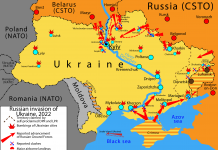
According to security researchers and experts, Europe could develop most of the essential defense capabilities required to deter or defeat Russia without U.S. assistance within five years—provided there is sufficient political commitment to invest in these areas.
Currently, European nations rely on the U.S. within the NATO alliance for critical support systems that enhance combat effectiveness. However, this reliance is increasingly uncertain as U.S. President Donald Trump has indicated a willingness to distance America from long-standing allies and forge closer ties with Russia.
Without key U.S.-provided military assets such as battlefield command and control (C2), satellite intelligence, and long-range strike capabilities, an alliance comprising the European Union, the U.K., and Norway could still counter Russia in a conventional conflict. However, experts caution that such a war would be far more costly and result in greater casualties.
Sven Biscop, director of the Europe in the World program at the Egmont Royal Institute for International Relations in Brussels, highlighted that Europe is not fully prepared for military operations without these enablers. “It doesn’t mean nothing can be done, but the approach would be much more improvised, leading to higher casualties and territorial losses,” he warned, emphasizing the urgency of addressing these gaps.
Among the capabilities where Europe is closest to self-sufficiency is military satellite communications, followed by unmanned intelligence, surveillance, and reconnaissance (ISR). A survey of 17 experts from European think tanks and institutions indicated that these capabilities are either already available or could be fully developed within three years.
The survey also assessed the time required for a European alliance to build sufficient capacity in nine key military enablers to effectively deter or confront Russia without U.S. support. The majority of analysts believed that Europe could achieve self-sufficiency in battlefield command and control, long-range strike, and suppression of enemy air defenses (SEAD) within five years. However, space-based ISR remained the most challenging area, with most experts estimating it could take between five and ten years to reach independence from U.S. support.
Biscop noted that Europe is still highly dependent on U.S. satellite intelligence, which will require significant time and investment to develop. Experts were divided on the continent’s aerial refueling and strategic airlift capabilities. While some believed Europe already possesses enough tanker and transport aircraft, others estimated it would take an additional three to five years to reach adequate capacity.
Airborne surveillance was another contested area, with about half of the experts believing that Europe could achieve critical capability within three years, while the other half projected it could take between three and ten years.
All estimates are contingent on European governments’ willingness to allocate the necessary funding. In 2024, only a few NATO members in Europe were spending more than 2.5% of their GDP on defense, while nearly a third were failing to meet the 2% target set by NATO in 2014.
Héloïse Fayet, a researcher at the Institut Français des Relations Internationales, emphasized the unpredictability of defense capability development, noting that external factors such as political will and budgetary decisions play a crucial role.
According to a February 21 analysis by researchers Alex Burilkov of Globsec GeoTech Center and Guntram Wolff of Bruegel, Russia could be capable of launching an attack on a European Union country within three to ten years, based on assessments from NATO, Germany, Poland, Denmark, and the Baltic states.
European NATO allies have time to prepare, but “this time must not be wasted, as has often been the case in Europe,” said Léo Péria-Peigné, a specialist in armament capacity at IFRI. He noted that while Russia is unlikely to pose a significant threat to the EU within the next five years due to its losses in Ukraine, Europe must still accelerate its defense build-up.
Although Europe’s military enabler development is currently underfunded, Péria-Peigné emphasized that the capabilities exist and can be expanded. “If we focus on action rather than discussion, Europe can be in a strong position within five years,” he stated.
Unlike the U.S., Europe does not need to match global military capabilities, as its focus is on territorial defense rather than worldwide operations, Biscop pointed out. However, he acknowledged that achieving this level of self-sufficiency would require substantial investment.
Poland’s rapid military expansion demonstrates that significant capabilities can be developed swiftly when governments commit the necessary resources, Péria-Peigné added. He also argued that Europe does not necessarily need cutting-edge military assets to counter a Russian offensive, given Ukraine’s ability to resist Russian aggression without many of these enablers.
“Russia is not China,” noted Péria-Peigné while adding, “Ukraine managed to hold off Russian forces despite lacking many advanced enablers, and it absorbed much of Russia’s military strength. While these enablers are valuable, Europe still possesses many of them and can fight without complete reliance on all.”
Some experts highlighted additional enablers not covered in the survey, such as combat engineering, airborne electronic attack capabilities, and improved military mobility.
Mihai Sebastian Chihaia, an analyst at the European Policy Centre, stressed that enhanced military mobility is crucial for deterrence. However, he pointed out that inadequate infrastructure and regulatory barriers currently hinder the swift movement of European armed forces.
While support enablers play a vital role in strengthening combat effectiveness, several analysts emphasized that Europe must also increase troop numbers and acquire more tanks, artillery, and other ground forces to offset the absence of U.S. military support.
Burilkov noted that land warfare should be Europe’s primary focus, as the most severe threat would be a direct Russian invasion of EU territory. Strengthening ground forces would significantly reduce the likelihood of a Russian breakthrough, he argued.
A U.S. withdrawal, coupled with a U.S.-Russia agreement over Ukraine that allows Moscow to continue rebuilding its military, could force Europe to compensate for the absence of around 300,000 U.S. troops, primarily by expanding its mechanized and armored forces, according to Burilkov and Wolff.
Despite these challenges, Biscop remains confident in Europe’s ability to prevail in a conventional war against Russia. “We have the population size and economic strength to win,” he said. “What’s needed is to complete our European force package to ensure full operational readiness—because deterrence is about making Russia think, ‘We’re not going to start this.’”




